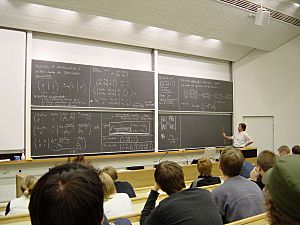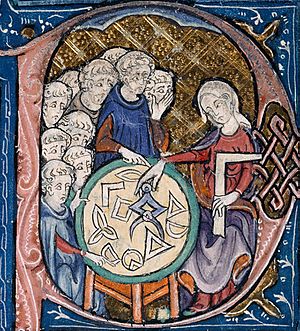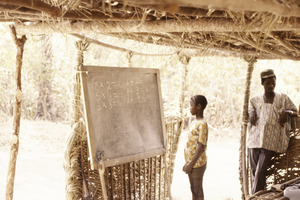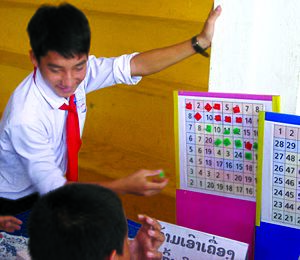Mathematics education facts for kids
Mathematics education is all about how we teach and learn mathematics. It also includes the special studies (research) that look into the best ways to do this.
Experts who study math education want to find the best tools, methods, and ideas to help people learn math. This field of study is huge! It has its own ideas, theories, ways of doing things, groups, meetings, and books. This article will tell you a bit about its history, what has influenced it, and some recent discussions.
Contents
History of Learning Math
Learning basic math has been a part of schooling in many old civilizations. This includes places like Ancient Greece, the Roman Empire, ancient India, and ancient Egypt. Back then, formal education was usually only for boys from rich or important families.
In ancient Greece, a famous thinker named Plato divided learning into two main parts: the trivium and the quadrivium. The quadrivium included math subjects like arithmetic (working with numbers) and geometry (studying shapes and spaces). This way of teaching continued in universities in Europe during the Middle Ages. Geometry was almost always taught using a famous book called Elements by Euclid. People learning trades, like builders or merchants, would learn the math they needed for their jobs.
During the Renaissance (a time of great change in Europe), math wasn't seen as important in schools. It was linked to business and trade, and some even thought it wasn't very Christian. Even though it was still taught in universities, it was considered less important than subjects like science or moral philosophy. The first modern way of teaching arithmetic (starting with adding, then subtracting, multiplying, and dividing) began in Italy in the 1300s. These methods were for business and spread along trade routes. This was different from the more philosophical math taught in universities.
The first math textbooks in English and French were written by Robert Recorde, starting in 1543. But there are much older writings about math and how to teach it, going back to 1800 BCE! These were mostly found in Mesopotamia, where the Sumerians practiced multiplication and division. They even had ways to solve complex equations. Later, in Egypt, famous math texts like the Rhind Mathematical Papyrus were like early textbooks for students.
By the 1600s, studying math became more respected. Universities started creating special positions for math professors. For example, the University of Aberdeen got a Math Chair in 1613.
In the 1700s and 1800s, the Industrial Revolution caused many people to move to cities. Basic number skills, like telling time, counting money, and simple math, became super important for city life. Math became a key part of the school curriculum from a young age.
By the 1900s, math was a core subject in schools in all developed countries. Also, in the 20th century, math education became its own field of study and research. Here are some important steps in its development:
- In 1893, a special position for math education was created at the University of Göttingen in Germany.
- The International Commission on Mathematical Instruction (ICMI) was started in 1908.
- By 1941, there were over 4000 articles on math education research in the USA.
- Interest in math education grew again in the 1960s.
- The first big international meeting for math education (ICME) happened in France in 1969. Since then, it has been held every four years.
In the 20th century, the "electronic age" also changed how math was taught. Before, teaching focused on solving specific problems. But then, new ideas came up, like teaching young children about number theory and set theory.
Why We Learn Math
Over time and in different places, math education has aimed for many goals. Some of these goals include:
- Teaching basic number skills to everyone.
- Teaching useful math (like arithmetic, elementary algebra, geometry, and trigonometry) to most students so they can work in trades or crafts.
- Teaching advanced math ideas (like sets and functions) early on.
- Teaching parts of math (like Euclidean geometry) to show how a logical system works.
- Teaching parts of math (like calculus) to show amazing human achievements.
- Teaching advanced math to students who want careers in science, technology, engineering, and mathematics.
- Teaching problem-solving skills to figure out new or tricky problems.
- Teaching math for subjects like social sciences, insurance math, and even some arts.
How We Learn Math
The way math is taught depends a lot on what the education system wants to achieve. Here are some common ways math is taught:
- Classical education: This old method taught math as part of the "quadrivium." It often used Euclid's Elements to teach logical thinking.
- Computer-based math: This approach uses computer software as the main tool for doing calculations.
- Computer-based mathematics education: This involves using computers and even mobile apps to help teach math.
- Traditional approach: This guides students step-by-step through math ideas and skills. It usually starts with arithmetic, then adds Euclidean geometry and elementary algebra at the same time.
- Discovery math: In this method, students learn by solving problems and exploring ideas on their own. They might use open-ended questions and hands-on tools. This method is used in some parts of Canada, but it's also debated because some think it leads to lower math scores compared to traditional teaching.
- Exercises: This means practicing math skills by doing many similar problems, like adding fractions or solving quadratic equations.
- Historical method: This teaches math by looking at how it developed over time, and how it was used in different societies and cultures. This can make math more interesting.
- Mastery: This approach expects most students to become very good at a math topic before moving on to the next.
- New Math: This method, popular in the US in the 1960s, focused on abstract ideas like set theory and different number systems. It was criticized because some felt students didn't learn basic skills well. A famous song even joked about it, saying the important thing was to "understand what you're doing, rather than to get the right answer."
- Problem solving: This method helps students become creative and clever at math by giving them unusual or unsolved problems. These can be simple word problems or complex challenges from math competitions. It helps students build new math knowledge.
- Recreational mathematics: Fun math problems can make students excited to learn and enjoy math more.
- Standards-based mathematics: This is a plan for math education in the US and Canada that focuses on students deeply understanding math ideas and how to do them.
- Relational approach: This method connects math topics to everyday problems and current events. It helps students see why math is useful and how to use it in real life.
- Rote learning: This means learning math facts, definitions, and formulas by repeating and memorizing them, sometimes without fully understanding why they work. It's often used for things like multiplication tables.
What Math We Learn and When
The math topics taught and the order they are taught in can differ between countries. Sometimes, a class might be taught earlier than usual if it's a special or advanced class.
Basic math is taught similarly in most countries, but there are differences. Many countries cover fewer topics but go into more depth than in the United States. In primary school, children learn about whole numbers, adding, subtracting, multiplying, and dividing. They also learn about comparing, measuring, fractions, patterns, and basic geometry.
In high school, in most of the U.S., algebra, geometry, and pre-calculus/calculus are taught as separate courses in different years. In many other countries (and some U.S. states), math is taught in an "integrated" way, meaning topics from all areas of math are studied each year. Students in science-focused programs usually study differential calculus and trigonometry around age 16–17. In their final year of high school, they might learn integral calculus, complex numbers, analytic geometry, exponential and logarithmic functions, and infinite series. Probability and statistics might also be taught in high school.
At college and university, students studying science or engineering usually take multivariable calculus, differential equations, and linear algebra. Math majors go on to study many other areas of pure mathematics and applied mathematics. For example, civil engineers might study fluid mechanics, and "math for computer science" could include graph theory and proofs.
Math Standards
For most of history, math education standards were set by individual schools or teachers. They decided what students should learn based on what was useful and appropriate for them.
Today, many regions or countries have national standards for math education. For example, in England, math standards are part of the National Curriculum. Many other countries have central government departments that set national standards, and sometimes even choose the textbooks.
Research has shown that students who take more math courses in high school tend to score higher on math tests. This led some places to require more years of math.
In North America, the National Council of Teachers of Mathematics (NCTM) published important guidelines for math education in 2000. These guidelines encouraged a new way of teaching math. In 2010, most US states adopted the Common Core State Standards for math. These standards are guidelines, and states can choose to change or add to them.
The Programme for International Student Assessment (PISA) is a global program that tests 15-year-old students in reading, science, and math. It was first done in 2000 with 43 countries. PISA repeats this test every three years to compare how students are doing around the world. The results often lead to changes in education policies.
Math Education Research
While we don't have perfect theories for classroom teaching yet, there's a lot of useful research on how children learn math. Many studies have explored how these ideas can be used in teaching. Here are some important findings:
- Important Results
One key finding is that giving students a "chance to learn" is super important for good teaching. Teachers can set expectations, time, types of tasks, questions, and discussions that help students learn. This means students need to learn both skills and understand the ideas behind them.
- Understanding Concepts
Two important things for helping students understand math ideas are:
- Clearly focusing on the concepts.
- Letting students struggle a bit with important math problems.
When teachers clearly explain how facts, procedures, and ideas connect, it helps students understand. For example, in East Asian countries, teachers spend a lot of time making these connections. This can involve explaining what a math step means, comparing different ways to solve problems, or reminding students of the main point.
"Productive struggle" means that when students work hard on math ideas, even if they get confused or make mistakes at first, they learn more. This is true whether the struggle comes from challenging teaching or from students trying to make sense of something on their own.
- Formative Assessment
Formative assessment is a great way to help students learn more, get more involved, and make teachers happier. It works better than just making classes smaller or giving teachers more math knowledge. Good assessment means knowing what students should learn, creating activities to see what they know, giving helpful feedback, encouraging students to take charge of their own learning, and letting students help each other.
- Homework
Homework that helps students practice old lessons or get ready for new ones is more helpful than homework that just reviews today's lesson. Students learn best when they get feedback. For younger children, homework helps with simple skills, but not always with bigger learning goals.
- Students Who Struggle
Students who have real difficulties with math (not just because they're not motivated) might struggle with basic facts, answer too quickly, have trouble picturing math ideas, have poor "number sense," or have bad short-term memory. Helpful ways to support these students include: students helping each other, clear teaching with pictures, teaching based on what assessments show, and encouraging students to think out loud.
- Algebraic Thinking
Younger students need a lot of time to learn to describe algebraic ideas without using symbols before they learn the actual math symbols. When they start using symbols, many students think letters always mean an unknown number and struggle with the idea of a variable (a letter that can stand for different numbers). They often prefer to solve word problems using arithmetic instead of algebra. It takes time to move from arithmetic to using algebra to describe patterns. Students also often have trouble with the minus sign and think the equals sign just means "the answer is..."
How Research is Done
Like other studies about people, math education research uses both number-based (quantitative) and description-based (qualitative) studies. Quantitative research uses numbers and statistics to answer questions, like whether one teaching method works better than another. The best quantitative studies involve randomly assigning different teaching methods to groups of students to see the effects.
Qualitative research, like case studies or interviews, looks at smaller groups in detail to understand how and why students learn. These studies can't prove one method is better, but they help us understand *why* something works. Both types of studies are important in education. Many studies combine both quantitative and qualitative methods.
Randomized Studies
There has been some discussion about which types of research are strongest. Because randomized studies can show clear evidence of "what works," policymakers often prefer them. Some experts want more random experiments where teaching methods are randomly given to classes. In other fields, like medicine, these controlled, random experiments are the preferred way to test treatments.
However, many education experts argue against increasing these types of experiments. They point out that it can be hard to randomly assign students to different treatments when we don't know the effects yet, or to control everything perfectly in a real school setting.
In the United States, a group called the National Mathematics Advisory Panel (NMAP) published a report in 2008 based on studies, some of which used random assignments. The NMAP's preference for these studies was criticized by some. Later, a government research arm expanded its research to include other types of studies too.
Organizations That Help With Math Education
- Advisory Committee on Mathematics Education
- American Mathematical Association of Two-Year Colleges
- Association of Teachers of Mathematics
- Canadian Mathematical Society
- C.D. Howe Institute
- Mathematical Association
- National Council of Teachers of Mathematics
- OECD
|
See also
 In Spanish: Educación matemática para niños
In Spanish: Educación matemática para niños





